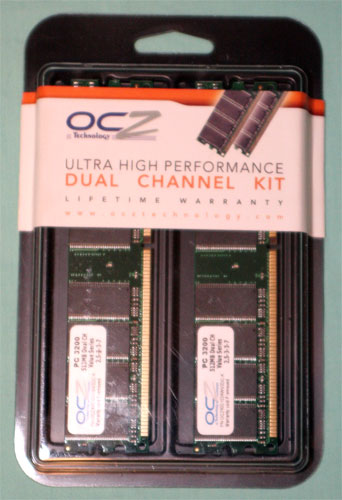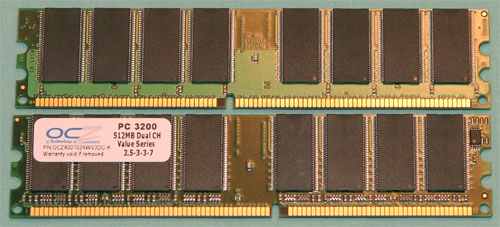Value RAM Roundup: Computing On a Budget
by Wesley Fink on April 11, 2005 4:26 PM EST- Posted in
- Memory
OCZ PC3200 Value Series: "Value VX"
OCZ VX emerged as our memory performance leader in our recent memory review, OCZ VX Revisited: DDR Updates on DFI nForce4. Rated at DDR500 speed at 2-2-2 timings, we quickly learned that you needed a lot of memory voltage to get the most from this memory. In fact, VX really requires 3.5V to 3.6V for best performance. This requires one of the new DFI nForce4 motherboards, an add-on OCZ DDR Booster, or a motherboard memory voltage mod to provide the voltages VX demands.The other part of the VX equation was cost. OCZ bins VX and tests at DDR500 2-2-2 speed, and the cost of that selectivity and guaranteed performance is about $270 for a Gigabyte of RAM. As performance RAM goes, this is a bargain price, but we never considered VX a Value RAM until OCZ dropped a surprise on our doorstep.
With the introduction of DDR500 VX, OCZ announced that they would be also producing a "Value VX" rated at DDR400 and lower voltage. Basically, this Value VX would be an unbinned part not tested for high voltages and high overclocks. That "Value VX" is now on the market as OCZ PC3200 Value Series and selling for about $115 for a pair of 512MB DIMMs!


Specifications
OCZ rates Value VX at the very conservative 2.5-3-3-7 at DDR400 at default voltage. The memory does meet these specs, but when you crank up the voltage, these "Value VX" DIMMs turn into a different animal.| OCZ PC3200 Value (DDR400) Memory Specifications | |
| Number of DIMMs & Banks | 2 DS |
| DIMM Size Total Memory |
512 MB 1GB |
| Rated Timings | 2.5-3-3-7 at DDR400 |
| SPD (Auto) Timings | 2.5-3-3-7 |
| Rated Voltage | 2.6V |
There is no mention on the innocent "OCZ PC3200 Value Series" label of what lurks within.
Test Results
| OCZ PC3200 Value (DDR400) - 2 x 512Mb Double-Bank | |||||||
| CPU Ratio at 2.4GHz | Memory Speed |
Memory Timings & Voltage |
Quake3 fps |
Sandra UNBuffered | Sandra Standard Buffered |
Super PI 2M places (time in sec) |
Wolfenstein - Radar - Enemy Territory fps |
| 12x200 | 400 DDR | 2-2-2-6 3.0V 1T |
570.2 | INT 2940 FLT 2929 |
INT 6096 FLT 6148 |
81 | 120.0 |
| 11x218 | 436 DDR | 2-2-2-6 3.1V 1T |
579.6 | INT 3138 FLT3117 |
INT 6478 FLT 6412 |
80 | 120.9 |
| 10x240 | 480 DDR | 2-2-2-6 3.2V 1T |
593.4 | INT 3242 FLT 3352 |
INT 6746 FLT 6789 |
79 | 122.7 |
| 11x245 (2.7GHz) |
Highest CPU/Mem Performance 490 DDR |
2-2-2-6 3.3V 1T |
613.6 | INT 3384 FLT 3459 |
INT 7284 FLT 7204 |
72 | 129.1 |
The binned and tested OCZ PC4000 VX reaches a higher speed of DDR530 at 2-2-2. That just proves the value of binning and testing for performance. But how can we complain about a memory that costs 57% less than 4000 VX and still performs with complete stability at DDR490 at 2-2-2 timings? Frankly, we can't.
You bargain hunters who want to play with VX, 2-2-2 timings, and high memory voltage will want to grab a pair of Value VX. They aren't binned, but we suspect that most will reach DDR480 to DDR500 if you supply the voltage - and some may do even better. That translates into a Clock frequency of 240 to 250, which should be more than enough to supply 1:1 2-2-2 to any AMD A64 at stock multiplier. A 2.4GHz 4000+ would be 2.88 to 3.0GHz at 240 to 250, for example - probably more than what the CPU can do with air cooling. At $115, for a Gigabyte of Value VX, there is now no price barrier to providing 2-2-2 1:1 memory for any AMD CPU - provided you can supply the voltage.
Aida 32 is now available as Everest Home Edition, a free download from www.lavalys.com.
| OCZ PC3200 Value (DDR400) 2x512Mb Double-Bank Everest 1.51 |
|||||
| CPU Ratio at 2.4GHz | Memory Speed | Memory Timings & Voltage |
Everest READ MB/s |
Everest WRITE MB/s |
Everest Latency ns |
| 12x200 | 400 DDR | 2-2-2-6 3.0V 1T |
5877 | 2033 | 45.8 |
| 11x218 | 436 DDR | 2-2-2-6 3.1V 1T |
6170 | 2056 | 44.6 |
| 10x240 | 480 DDR | 2-2-2-6 3.2V 1T |
6666 | 2207 | 44.2 |
| 11x245 (2.7GHz) |
Highest CPU/Mem Performance 490 DDR |
2-2-2-6 3.3V 1T |
8310 | 3321 | 35.2 |
Performance patterns are exactly the same as seen in our recent reviews of VX memory. The unbinned $115 DDR400 memory reached DDR490, while the binned $270 DDR500 version reached DDR530 - with 2-2-2 timings all around. If you want assured performance, go for the DDR500 tested part. If you want low price and lots of potential, OCZ PC3200 Value Series has your name on it.










102 Comments
View All Comments
ChineseDemocracyGNR - Tuesday, April 12, 2005 - link
#39,"2) RAM multipliers are usually limited. If you have a standard set of 400, 320, and 266 speeds, you could only achieve DDR400 speed at a CPU frequency of 250. Anything lower than that would be running the RAM at less than 400. Most A64 CPUs can't do 250 on air at stock multipliers (the low end ones can) so they will be running less than optimum ram speed. That's where you could lower CPU multipliers or use a board like the DFI with lots of intermediate RAM ratios. "
I'm not sure I'm following.
With a 9x CPU multiplier, DDR266 memory divider and 312MHz reference clock the memory would be running at DDR400.
With a DDR200 option you could go up to 400MHz on the reference clock. That means that no DDR400 memory will limit the overclock of a CPU with a 9x multiplier.
"1) There is an Asynchronous Latency penalty, which can be tweaked somewhat on boards with better BIOS options like the DFI. It is not, hoever, the kind of asynchronous penalty you see on a FSB board like Intel. "
In my own tests there's no real-world penalty at all. I compared an Athlon 64 running at:
REFCLOCK: 200MHz
Memory Divider: DDR400
CPU multiplier: 9x
LDT: 5x
with:
REFCLOCK: 300MHz
Memory Divider: DDR266 (DDR400 effective)
CPU multiplier: 6x
LDT: 3x
The results where near identical.
"In other words, the easiest way to consistently improve memory performance is 1:1 memory speed."
There's no memory fast enough to run at 1:1 with an Athlon 64. ;)
An Athlon 64 at 9*200 is on a 1800/9 ratio with DDR400 memory.
I'm sorry but I stand by what I said before, there's no reason to invest in memory if you want to overclock your Athlon 64, only if you want to overclock the memory as well.
Kind of on the subject, I hope the round up of AMD PCI-E boards (there is one coming right?) tests the best reference clock the motherboards can achieve without memory as a limiting factor, unlike the reviews before.
PrinceGaz - Tuesday, April 12, 2005 - link
Excellent review, both for the modules it covered and what it didn't.One small point- there is no such thing as 1:1 memory timings with A64 processors. The reduced latency and higher performance that a 1:1 ration gave when the processor to chipset FSB was running synchronously with the chipset memory-controller, is irrelevant with the Athlon 64 as there is no intermediate bus operating at a differnt speed to the memory controller to cause overheads. Selecting a lower memory speed just changes the CPU:Memory ratio in the processor.
The memory on an Athlon 64 system works just as efficiently (though ay a lower bandwidth of course) if set to DDR333 as it does at DDR400, which means there is no real penalty when overclocking in choosing a lower memory speed to compensate for the increasing bus speed.
Olaf van der Spek - Tuesday, April 12, 2005 - link
http://anandtech.com/memory/showdoc.aspx?i=2392&am...> Transcend is another memory that costs just $100 for a Gigabyte and yet manages to nearly reach DDR550 in overclocking.
550?
The table claims 510 (2 x 223), but 2 x 223 = 446.
Olaf van der Spek - Tuesday, April 12, 2005 - link
Is Lavalys sponsoring this article? Why is that paragraph repeated on every page?JustAnAverageGuy - Tuesday, April 12, 2005 - link
I would have liked to see Mushkin Blue($147 per GB)
http://www.newegg.com/app/viewproductdesc.asp?desc...
and Corsair VS 2.5
($174 per gb)
http://www.newegg.com/app/ViewProductDesc.asp?desc...
I won't whine about the voltage, that's been done before :)
Olaf van der Spek - Tuesday, April 12, 2005 - link
-LX - Tuesday, April 12, 2005 - link
Why isn't the OCZ4001024WV3DC-K on the OCZ site???CobraT1 - Tuesday, April 12, 2005 - link
If you are interested in the OCZ Value VX, note the differences in the two part numbers, one with a "W" and one without.Value VX = OCZ4001024WV3DC-K
2.5-3-3-7 (picture) Supports EVP (Extended Voltage Protection)
Value = OCZ4001024V3DC-K
3-4-4-8 Does not Support EVP
See this link for both.
http://www.newegg.com/app/searchProductResult.asp?...
Hope this clears up the confusion.
segagenesis - Tuesday, April 12, 2005 - link
Wesley - Fair enough. But when that ATACOM link posted in #44 shows 3-4-4 even on the label in the picture its hard to tell who to believe (and its hard to read the part # on it). If its all the same chip then fine... but why label it differently then? Buyer beware?Maybe I am off base...
Turin39789 - Tuesday, April 12, 2005 - link
I get real tired pushing ferrari's out of my driveway. There isnt any racing alcohol available to me, sometimes I have my neghbor tow me to work in his chevrolet cobalt